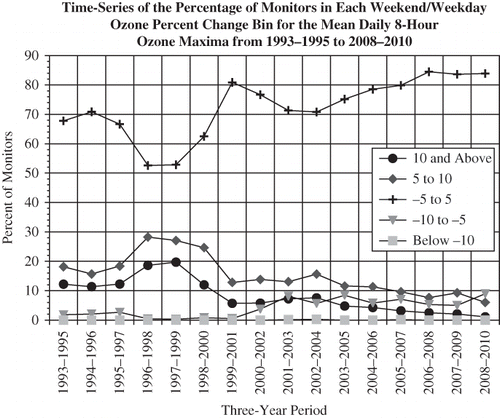Abstract
A national analysis of weekday/weekend ozone (O3) differences conducted using 1997–1999 data found that many urban areas experienced at least 5% higher 8-hr maximum O3 concentrations on weekends than on weekdays even though emissions of precursors were significantly lower on weekends. This phenomenon was observed mostly in urban areas in the Northeast, Midwest, and coastal California. A similar analysis using 2008–2010 O3 data shows that this phenomenon has mostly vanished. From 1997–1999 to 2008–2010, the percentage of U.S. monitoring sites that experienced 95th percentile daily 8-hr maximum average O3 concentration on weekends that were 5% or more higher than on weekdays declined from about 35% to less than 5%. At the same time the percentage of sites that experienced higher weekday concentrations increased from 3% to about 27%. The majority (68%) of the sites, however, exhibited little sensitivity to the weekday/weekend emission changes as they had similar (±5%) O3 on weekdays and weekends. Similar trends were observed for the three other O3 metrics examined: the 95th percentile of the 1-hr maximum and the April–September means of the 1-hr and 8-hr daily maxima. Over this time period, U.S. emissions of O3 precursors declined significantly. However, a greater decline in nitrogen oxides (NOx) emissions has caused an increase in the volatile organic compounds (VOC)/NOx emission ratios and it appears that this is the reason for the shift away from higher weekend O3 concentrations.
In areas where weekend emissions of ozone precursors are lower than on weekdays because of mainly lower motor vehicle emissions, an inadvertent test of ozone control strategies occurs. Such a test provides information on how control strategies that produce emission changes similar to those that occur on weekends affect ozone concentrations. In the late 1990s, lower NOx emissions on weekends resulted in higher levels of ozone in many urban areas. Emission controls that have been enacted since then appear to have eliminated that phenomenon in most urban areas. However, most areas now indicate that weekend emission reductions now have little effect on ozone concentrations at most sites.
Introduction
In simple terms, the ozone “weekday/weekend effect” is the occurrence of higher maximum surface ozone concentrations on average in many urban areas on weekends than on weekdays despite lower emissions of ozone precursors, volatile organic carbon compounds (VOCs) and nitrogen oxides (NOx), on weekends. Although this phenomenon was first observed in the mid 1970s (CitationCleveland et al., 1974; CitationLabron, 1975; CitationLevitt and Chock, 1976), detailed data analysis (CitationMarr and Harley, 2002a; CitationHeuss et al., 2003; CitationPun and Seigneur, 2003; CitationFujita et al., 2003a; CitationBlanchard and Tanenbaum, 2003, Citation2005, Citation2008; CitationBlanchard et al., 2008), field studies (CitationChinkin et al., 2003; CitationFujita et al., 2003b), and modeling studies (CitationMar and Harley, 2002b; CitationYarwood et al., 2003, 2007, 2008) to document the geographic extent and the mechanisms responsible for this behavior have only been recently conducted.
Although the earlier studies highlighted the existence of higher weekend ozone concentrations in some urban areas, the later modeling and measurement studies revealed much more complex relationships that vary with geographic location and meteorological conditions, and there is some evidence that they are changing over time (CitationPun and Seigneur, 2003; CitationFujita et al., 2003a). Collectively, these studies show that in some urban areas, the ozone is higher on weekends, while in others it is lower or essentially the same. The studies also reveal significantly lower concentrations of ozone precursors on weekends particularly in urban areas that have been attributed primarily to lower emissions from motor vehicles (CitationFujita et al., 2003a; CitationBlanchard and Tanenbaum, 2003; CitationChinkin et al., 2003; CitationFujita et al., 2003b). An examination of anthropogenic emission inventories indicates the weekend reductions in NOx are significantly greater than the reductions in VOCs (CitationChinkin et al., 2003; CitationYarwood et al., 2003, 2007, 2008; CitationKoo et al., 2011). For example in the Midwest, CitationKoo et al. (2011) reports emission declines for NOx of 23.7% on Saturdays and 49.9% on Sundays while the VOC decreases are 7.0% on Saturdays and 20.0% on Sundays. Since the average weekday to weekend changes in ozone are generally in the range of ±10%, they are significantly less than the emission changes even at the ozone sites that experience weekend declines.
Two reasons for the varying observed responses of ozone to changes in precursor emissions are the complex, nonlinear chemistry of ozone formation, which is critically dependent upon the local VOC to NOx ratio in the atmosphere (CitationNational Research Council, 1991; CitationHeuss et al., 2003; CitationWolff and Korsog, 1992), and the fact that a large portion of the observed local ozone concentration is due to ozone transported from upwind areas. At low VOC/NOx conditions (<10 ppb C to ppb NOx), VOC is generally the limiting reactant. At very low ratios, there will be an increase in ozone production with a decrease in NOx emissions. At high ratios (>10), NOx becomes the limiting reactant and ozone formation becomes more efficient with the addition of NOx. Since the observed weekend reductions in NOx emissions are about three times greater that the reduction in VOCs, the weekends will have higher VOC/NOx ratios than the weekdays. This has been documented in observations by a number of investigators (CitationCleveland et al., 1974; CitationLabron, 1975; CitationLevitt and Chock, 1976; CitationBlanchard and Tanenbaum, 2003; CitationChinkin et al., 2003; CitationFujita et al., 2003b).
Thus, the change in emissions from weekday to weekend is an inadvertent test in the response of ozone concentrations to precursor emission decreases. Since future control strategies are expected to decrease NOx emissions faster than VOC emissions (CitationYarwood et al., 2007), the increase in the ozone formation per molecule of NOx could offset or negate desired ozone reductions due to lower NOx emissions, as observed at many areas on weekends. Beyond a certain point, additional reductions in NOx will result in ozone reduction.
In 2003, we conducted a national analysis of the ozone weekday/weekend effect and generated U.S. maps for the 1997–1999 time period. These maps showed the distribution of ozone monitors around the U.S. that were experiencing higher, lower, or the same ozone concentrations on weekends relative to weekdays (CitationHeuss et al., 2003). The maps contained 95th percentile ozone concentrations for both the daily maximum 1-hr values and the daily maximum 8-hr concentrations (see and in CitationHeuss et al., 2003). In 2003, we summarized the ozone weekday/weekend geographical distributions:
Figure 1. By-monitor percent change from average weekday to weekend 95th percentile 1-hr O3, 2008–2010.
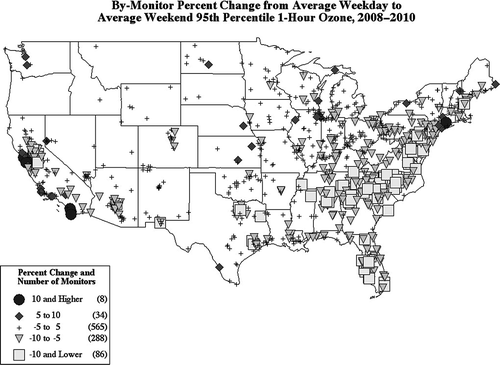
Figure 2. By-monitor percent change from average weekday to weekend 95th percentile 8-hr O3, 2008–2010.
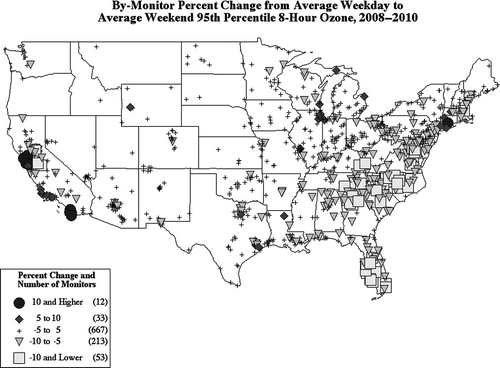
Figure 3 maps the results at 1206 sites for the 95th percentile 1-hr daily maximum O3 concentrations as the percentage change from weekday to weekend days. There are 131 monitoring sites in which the weekend O3 was increased by 10% or more and 200 sites with an increase of from 5 to 10% on weekends. There were 750 sites with substantially similar 95th percentile O3 on weekdays and weekends (within ±5%) and 125 with at least 5% lower O3 on weekends. The higher weekend O3 sites are primarily located in and around major cities in the coastal areas of California, the Midwest, and the Northeast Corridor. There is a difference between the Northeast and Southeast, with most of the Southeast sites experiencing either similar or lower O3 on weekends. (CitationHeuss et al., 2003, p. 775)
We also wrote,
The results for the 95th percentile of 8-hr O3 maximums are shown in The spatial distribution for the 95th percentile 8-hr O3 maxima is similar to that for the 95th percentile 1-hr maxima in However, the number of sites with at least 5% greater O3 on weekends is increased from 331 to 416, while the number of sites with at least 5% lower O3 on weekends is decreased from 125 to 62. (CitationHeuss et al., 2003)
Scope of Work
Since 1997–1999, ozone concentrations and emissions of precursors have declined significantly throughout the United States (CitationU.S. Environmental Protection Agency [EPA], 2011a, Citation2012). As a result, we decided to revisit our earlier analysis to see how these emission changes may have affected the geographical distribution of the weekend/weekday effect over the last decade. The first task of the present study was to verify that the 1997–1999 maps that were constructed nearly a decade ago could be duplicated. In going forward in time, it would be more meaningful to compare the year-to-year percentages in each of the five bins (i.e., ≥10%, ≥5 to <10%, ≤–10%, >–10% to ≤–5%, and ≥–5% to <5%) rather than the number of stations since the total of ozone monitors changes from year to year. In addition, for consistency, an April 1 to October 31 time frame was used, rather than a variable ozone season (depending upon the geographic region). The data completeness criterion for including a monitor was 75% of the days in a given year.
Results
Using the preceding criteria, the 95th percentile maps for 1997–1999 for the 1-hr and 8-hr ozone maps were constructed and they are shown in and The main features of these maps are identical to the features of the maps in the 2003 publication that are described in the preceding section. Similar maps for the latest period, 2008–2010, are shown in and The changes between the two sets of maps are significant. The areas that had higher weekend ozone in 1997–1999 have largely vanished by 2008–2010 over most of the United States.
Figure 3. By-monitor percent change from average weekday to weekend 95th percentile 1-hr O3, 1997–1999.
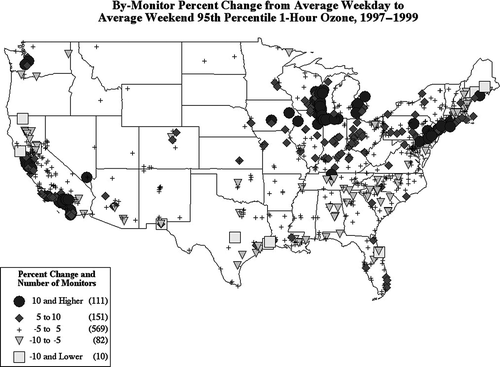
Figure 4. By-monitor percent change from average weekday to weekend 95th percentile 8-hr O3, 1997–1999.
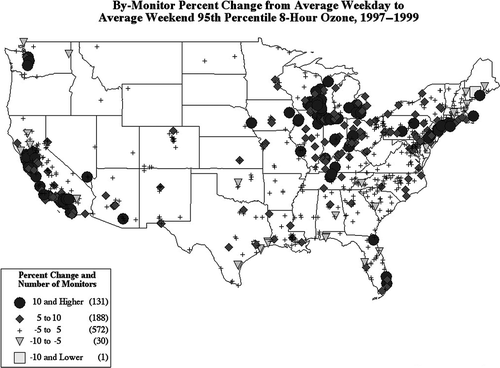
To see how such changes evolved over time, time series of the percentages of monitoring stations in each of the five bins were constructed from 1993–1995 to 2008–2010, and these are illustrated in and for the 95th percentiles and and for the daily means. It appears that the largest decline in higher weekend ozone values began from 1996–1998 to 1999–2001. After that, a slower decline is still evident.
Figure 5. Time-series of the percentage of monitors in each weekend/weekday O3 percent change bin for the 95th percentile daily 1-hr O3 maxima from 1993–1995 to 2008–2010.
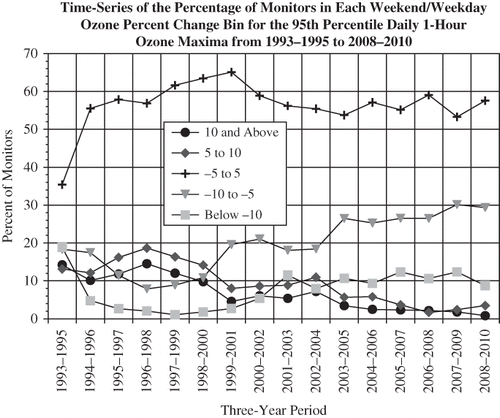
Figure 6. Time-series of the percentage of monitors in each weekend/weekday O3 percent change bin for the 95th percentile daily 8-hr O3 maxima from 1993–1995 to 2008–2010.
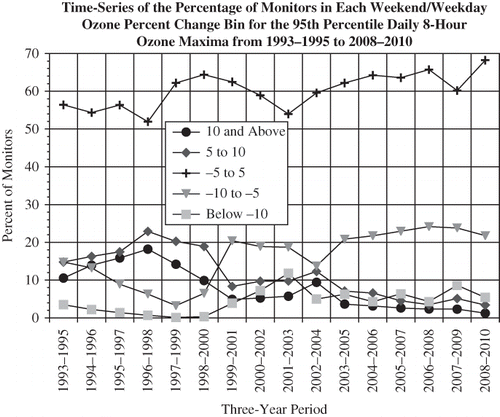
Discussion
A comparison of and with and reveals that between 1997–1999 and 2008–2010 there were significant changes in the weekday/weekend responses of observed ozone to the differing emission patterns that occur on weekends relative to weekdays. The data presented in Figures indicate that the greatest changes seemed to occur in the 1996–1999 to 1999–2001 time frame, with smaller changes occurring since 1999–2001 to 2008–2010.
Although yearly variations in meteorology can have an effect on the weekend/weekday response to local ozone behavior, it is improbable that meteorological variations could produce the decade-long trends observed in the time-series plots for the entire United States. A much more plausible explanation is that the cause is long-term emission reduction programs, particularly ones that favor more NOx reductions than VOC reductions. A control strategy that lowers precursor emissions while simultaneously raising the VOC/NOx ratio could explain the observations.
The U.S. EPA's latest nationwide emissions trends (CitationU.S. EPA, 2011a) for total U.S. emissions for VOCs and NOx from 1990 to 2010 are plotted in Separate lines show the trends for total VOCs (anthropogenic and biogenic), anthropogenic alone, highway vehicle VOCs, total anthropogenic NOx, and highway vehicle NOx. Highway vehicle emissions were plotted separately because they may be the dominant driver of the VOC/NOx ratios in many urban areas. The U.S. EPA estimate of annual biogenic emissions (CitationU.S. EPA, 2011b) of 29 MT/yr is assumed to be constant from year to year. Also plotted in are three molar VOC/NOx ratios: total VOCs to anthropogenic NOx, anthropogenic VOCs to anthropogenic NOx, and highway vehicle VOCs to highway vehicle NOx. To calculate the ratios on a molar basis, two assumptions were made. First is that NOx is emitted in a 9:1 ratio of NO and NO2. Second is that the molecular weight of the VOCs is 105, which is the average molecular weight of gasoline.
Figure 9. Trends in U.S. emissions of VOCs and NOx and the molar ratio of VOC/NOx emissions from 1990 to 2008.
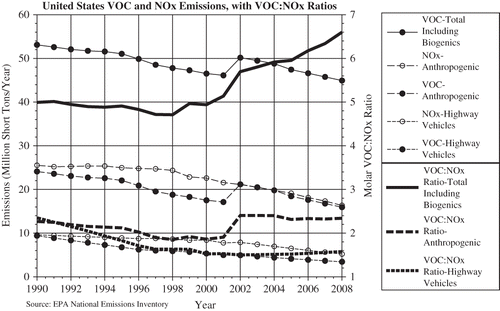
From , it appears that the curve that would best explain the weekend/weekday trends is the VOC/NOx curve that is based on the ratio of total VOC (anthropogenic plus biogenic) to total anthropogenic NOx. This curve is at a minimum of about 4.7 in 1997–1998 and gradually increases thereafter to a maximum value 6.6 in 2008. It should be noted that the abrupt increase in anthropogenic VOC emission from 2001 to 2002 represents a change in the U.S. EPA emission estimation methodology to calculate VOC emissions from wildfires. Even without the abrupt change, however, the trend in the VOC/NOx line is positive.
While there has been a general increase in national VOC/NOx ratios, there are regional differences in weekday/weekend behavior that are apparent, particularly when comparing the Midwest and Northeast with the Southeast and with California. A major difference between these major regions of the country is the presence of greater sources of biogenic VOC in the Southeast region that would raise the overall VOC/NOx ratio and tend to limit the effectiveness of VOC controls at the sites dominated by biogenic VOCs. This is the likely explanation for the major regional differences in weekend/weekday behavior that are observed in the Southeast.
An appreciable portion of the Southeastern U.S. sites had peak 1-hr ozone that was NOx-limited in the 1997–1999 period, as indicated in By 2008–2010, the Southeastern United States, as a whole, shows much stronger evidence of NOx limitation for both peak 1-hr and peak 8-hr ozone as shown in and Exceptions still exist in some urban areas. For example, an urban site centrally located in downtown Atlanta, GA, still exhibited VOC-limited behavior as late as 2007 (CitationBlanchard et al., 2010a). For the Midwest and Northeast, the strong evidence of VOC limitation in the 1997–1999 time period has mostly disappeared by 2008–2010. The generally similar ozone between weekdays and weekends in many areas of the Midwest and Northeast is an indication that ozone formation in these areas is in between the NOx- and VOC-limiting cases. Based on photochemical experiments and modeling, it is well established that there is a regime of maximum ozone formation between the two limiting cases. Therefore, the current weekday/weekend behavior in the region appears to indicate that the nation's ozone control strategy is pushing many sites into a regime of maximum ozone formation. At these sites, the major anthropogenic precursor reductions on the weekend do not result in ozone reductions because the reduction in emissions is accompanied by and offset by an increase in the rate of ozone formation.
In California, there are a number of urban areas that still exhibit a strong weekend enhancement of ozone ( and ). This is further illustrated in , which shows that more than 10% of the sites in California still fall into both the >+10% and +5 to +10% bins for the 95th percentile of the daily 8-hr ozone maxima. This compares to the nationwide percentages of about 2% and 4%, respectively (see ). This is consistent with the observations reported by CitationMarr and Harley (2002a) and CitationBlanchard et al. (2010b). Marr and Harley hypothesized that over the period from 1980 to 1999 the higher ozone on weekends became more widespread due to a shift in the ozone formation to a more VOC-sensitive regime as control programs in California reduced VOC emissions faster than NOx emissions, but on weekends NOx emissions were lower than on weekdays. Observations by CitationBlanchard et al. (2010b) of declining ambient VOC:NOx ratios indicate that this trend continued through at least 2000–2004 in central California. In contrast to California, the United States, as a whole, in 1999 began to reduce NOx emissions faster than VOC emissions, as evidenced by the rising VOC/NOx molar emission ratio in This faster decline in NOx emissions is a result of regulations (acid rain rules, NOx-SIP call, and the phase-in of the CAIR rules) that targeted the largest stationary NOx sources in the eastern half of the United States but had no effect in California.
Figure 10. Time-series of the percentage of California monitors in each weekend/weekday O3 percent change bin for the 95th percentile daily 8-hr O3 maxima from 1993–1995 to 2008–2010.

Even though the weekend increase in ozone is a vanishing phenomenon, the lack of an ozone decrease on weekends is still problematic. With more than 60% of sites having peak 8-hr weekend ozone within ±5% of weekday levels and more than 80% of sites having mean 8-hr weekend ozone within ±5% of weekday levels, this is a widespread phenomenon that demonstrates the complexity of ozone formation and control.
References
- Blanchard , C.L. and Tanenbaum , S.J. 2003 . Differences between weekday and weekend air pollutant levels in Southern California . J. Air Waste Manage. Assoc , 53 : 816 – 828 . doi: 10.1080/10473289.2003.10466222
- Blanchard , C. and Tanenbaum , S. 2005 . Weekday/Weekend Differences in Ambient Ozone and Particulate Matter Concentrations in Atlanta and the Southeastern United States , Alpharetta , GA : CRC Project A-47, Coordinating Research Council . doi: 10.1080/10473289.2003.10466222
- Blanchard , C.L. , Tanenbaum , S. and Lawson , D.L. 2008 . Differences between weekday and weekend air pollutant levels in Atlanta; Baltimore; Chicago; Dallas-Fort Worth; Denver; Houston; Houston; New York; Phoenix; Washington, DC; and surrounding areas . J. Air Waste Manage. Assoc , 58 : 1598 – 1615 . doi: 10.1080/10473289.2003.10466222
- Blanchard , C. and Tanenbaum , S. 2008 . Analysis of Day-of-Week Variations in Ozone and Ozone Precursor Concentrations in Southern Ontario , Golden , CO : NREL Subcontract No. LEV–8-88510-01, National Renewable Energy Laboratory . doi: 10.1080/10473289.2003.10466222
- Blanchard , C.L. , Hidy , G.M. and Tanenbaum , S. 2010a . NMOC, ozone, and organic aerosol in the southeastern United States, 1999–2007: 2. Ozone trends and sensitivity to NMOC emissions in Atlanta, Georgia . Atmos. Environ , 44 : 4840 – 4849 . doi: 10.1080/10473289.2003.10466222
- Blanchard , C.L. , Tanenbaum , S. , Fujita , E. , Wilkinson , J. and Campbell , D. 2010b . “ Effects of VOC and NOx emission changes on ozone and precursor concentrations in Central California from 1990 to 2004 ” . In Air Pollution Modeling and Its Application XX Edited by: Steyn , D.G. and Rao , S.T. 577 – 580 . Dordrecht, Netherlands: Springer. doi: 10.1080/10473289.2003.10466222
- Chinkin , L.R. , Coe , D.L. , Funk , T.H. , Hafner , H.R. , Roberts , R.T. , Ryan , P.A. and Lawson , D.R. 2003 . Weekday versus weekend activity patterns for ozone precursor emissions in California's South Coast Air Basin . J. Air Waste Manage. Assoc , 53 : 829 – 843 . doi: 10.1080/10473289.2003.10466222
- Cleveland , W.S. , Graedel , T.E. , Kleiner , B. and Warner , J.L. 1974 . Sunday and workday variations in photochemical air pollutants in New Jersey and New York . Science , 186 : 1037 – 1038 . doi: 10.1080/10473289.2003.10466222
- Fujita , E.M. , Stockwell , W.R. , Campbell , D.E. , Keisler , R.E. and Lawson , D.R. 2003a . Evolution of the magnitude and spatial extent of the weekend ozone effect in California's South Coast Air Basin . J. Air Waste Manage. Assoc , 53 : 802 – 815 . doi: 10.1080/10473289.2003.10466222
- Fujita , E.M. , Campbell , D.E. D.E. , Zielinska , B. , Sagebiel , J.C. , Bowen , J.L. , Goliff , W.S. and Stockwell , W.R. 2003b . Diurnal and weekday variations in the source contributions of ozone precursors in California's South Coast Air Basin . J. Air Waste Manage. Assoc , 53 : 844 – 863 . doi: 10.1080/10473289.2003.10466222
- Heuss , J. M. , Kahlbaum , D.F. and Wolff , G.T. 2003 . Weekday/weekend ozone differences: What can we learn from them? . J. Air Waste Manage. Assoc , 53 : 772 – 788 . doi: 10.1080/10473289.2003.10466222
- Koo , B. , Jung , J. , Pollack , A.K. , Lindhjem , C. , Jimenez , M. and Yarwood , G. 2011 . Regional Modeling of Weekday/Weekend Ozone Changes in the Midwestern US , Alpharetta , GA : CRC Project A-69-1, Coordinating Research Council . doi: 10.1080/10473289.2003.10466222
- Labron , F.A. 1975 . Comparison of weekend and weekday ozone and hydrocarbon concentrations on the Baltimore-Washington Metropolitan Area . Atmos. Environ , 9 : 861 – 863 . doi: 10.1080/10473289.2003.10466222
- Levitt , S.B. and Chock , D.P. 1976 . Weekday–weekend pollutant studies of the Los Angeles Basin . J. Air Pollut. Control Assoc , 26 : 1091 – 1092 . doi: 10.1080/10473289.2003.10466222
- Marr , L.C. and Harley , R. A. 2002a . Spectral analysis of weekday-weekend differences in ambient ozone, nitrogen oxide, and non-methane hydrocarbon time series in California . Atmos. Environ , 36 : 2327 – 2335 . doi: 10.1080/10473289.2003.10466222
- Marr , L. C. and Harley , R.A. 2002b . Modeling the effect of weekday–weekend differences in motor vehicle emissions on photochemical air pollution in Central California . Environ. Sci. Technol , 36 : 4009 – 4106 . doi: 10.1080/10473289.2003.10466222
- National Research Council . 1991 . Rethinking the Ozone Problem in Urban and Regional Air Pollution , Washington , DC : National Academy Press . doi: 10.1080/10473289.2003.10466222
- Pun , B.K. and Seigneur , C. 2003 . Day-of-week behavior of atmospheric ozone in three U.S. cities . J. Air Waste Manage. Assoc , 53 : 789 – 801 . doi: 10.1080/10473289.2003.10466222
- U.S. Environmental Protection Agency. 2011a. 1970–2011 Average annual emissions, all criteria pollutants. In MS Excel http://www.epa.gov/ttn/chief/trends/index.html (http://www.epa.gov/ttn/chief/trends/index.html) (Accessed: 22 March 2012 ).
- U.S. Environmental Protection Agency . 2011b . Integrated Science Assessment for Ozone and Related Photochemical Oxidants , Research Triangle Park , NC : U.S. EPA . EPA/600/R-10/076B doi: 10.1080/10473289.2003.10466222
- U.S. Environmental Protection Agency. 2012. Ozone trends http://www.epa.gov/airtrends/ozone.html (http://www.epa.gov/airtrends/ozone.html) (Accessed: 20 March 2012 ).
- Wolff , G.T. and Korsog , P.E. 1992 . Ozone control strategies based on the ratio of volatile organic compounds to nitrogen oxides . J. Air Waste Manage. Assoc , 42 : 1173 – 1177 . doi: 10.1080/10473289.2003.10466222
- Yarwood , G. , Stoechenius , T.E. , Heiken , J.G. and Dunker , A.M. 2003 . Modeling weekday/weekend ozone differences in the Los Angeles Basin for 1997 . J. Air Waste Manage. Assoc , 53 : 864 – 875 . doi: 10.1080/10473289.2003.10466222
- Yarwood , G. , Koo , B. and Grant , J. 2007 . Modeling Weekday/Weekend Emissions and Ozone in the Los Angeles Basin for 1997 and 2010 , Alpharetta , GA : CRC Project A-56, Coordinating Research Council . doi: 10.1080/10473289.2003.10466222
- Yarwood , G.B. , Koo , B. , Stoeckenius , T. and Heiken , J. 2008a . Modeling Weekend and Weekday Ozone in Southeast Michigan , Golden , CO : NREL subcontract no. ACE-5-55510-01, National Renewable Energy Laboratory . doi: 10.1080/10473289.2003.10466222
- Yarwood , G. , Grant , J. , Koo , B. B. and Dunker , A.M. 2008b . Modeling weekday to weekend changes in emissions and ozone in the Los Angeles Basin for 1997 and 2010 . Atmos. Environ , 42 : 3765 – 3779 . doi: 10.1080/10473289.2003.10466222

